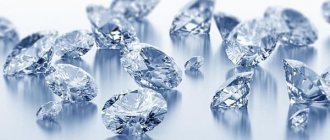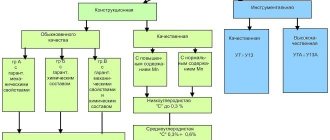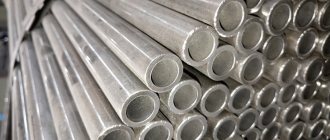Mechanical engineering parts and mechanisms, as well as tools intended for their processing, have a set of mechanical characteristics. Hardness plays a significant role among the characteristics. The hardness of metals clearly shows:
- wear resistance of metal;
- possibility of processing by cutting, grinding;
- resistance to local pressure;
- ability to cut other materials and others.
In practice, it has been proven that most of the mechanical properties of metals directly depend on their hardness.
How is hardness measured and how is it designated?
For most hardness measurement methods, the basic unit of measurement is kgf/mm2
However, you should understand that there are methods with their own unit.
The designation of hardness also depends on the method.
The letter “H” always denotes “hardness” (from the English Hardness), and then the letters indicating the determination method are indicated. The most popular designations:
- HB – Brinell method (pressing a steel ball)
- HRA - Rockwell method, A scale (diamond or steel cone indentation)
- HRB – Rockwell method, B scale
- HRC - Rockwell method, C scale
- HV – Vickers method (diamond pyramid indentation)
- HSD – Shore hardness, etc. (rebound method)
Characteristics of the Vickers technique
Another very simple method, which is distinguished by speed and accuracy, but the high cost of equipment. Let's list the features:
- A diamond pyramid with a more obtuse angle is used - 136 degrees at the apex.
- Deformation of more than 100 kgf is not allowed.
- The time taken is very short - from 10 to 15 seconds.
- You can measure the parameters of any material, including especially durable ones, as well as steels that have undergone heat treatment.
Sequence of research
- Check the surface layer of the part, as well as all equipment.
- Calculate the allowable force.
- Install the sample and secure it.
- Start the device and after 10-15 seconds analyze the result.
What are the requirements for the product to be measured?
Hardness is directly proportional to the load to determine it. High hardness – high load.
The more accurate the method, the higher the requirements for preparing the surface of the product. The surface of the product on which hardness is determined must meet a number of requirements:
- The thickness of the sample must be at least 10 times the depth of penetration of the tip after removing the main force.
- At the inspection site, it must be cleaned to a shine, be smooth and flat, and must be free of scale, rust, oil, fat and paint contamination, potholes and scratches. Roughness Ra is not more than 2.5 µm according to GOST 2789, unless there are other requirements of regulatory and technical documentation.
- The surface on which the sample “lays” on the object stage of the device must also be clean and level. Both surfaces must be parallel to each other.
- The product must be securely fastened, excluding the possibility of displacement of the sample relative to the axis of load application.
Concept
This term in materials science refers to a mechanical property that determines resistance to destruction under the influence of other, denser substances. Otherwise we can say this: this is resistance to deformation from pressure. In this case, both plastic and elastic changes are taken into account.
Many processes and conditions depend on the characteristics:
- Wear resistance is how long an element can be used. This includes wear and tear, since for every part, such as a car part, there comes a time when, for natural reasons, it needs to be replaced. But the harder the element, the longer it will last under certain conditions.
- Possibility of various types of metalworking - some technologies are applied only to soft alloys, while others can be used for durable ones.
- Resistance to pressure and other forces is characteristic of a shaft or bearing that is subject to centrifugal and frictional forces.
- The ability to use a material as a tool for a more pliable surface. Tool steel is so strong that it is used to make cutters for milling machines, drills and other products.
This is not a complete list of what the hardness of a metal affects after we have defined it. Not every substance used has the same characteristics. What is done first of all to increase this parameter? First, we take raw materials, clean them of impurities, and then subject them to chemical and temperature treatment. Namely: we add various alloying components to the composition that increase this quality, for example:
- Chromium. Strength and corrosion resistance increases, ductility and susceptibility to magnetic forces are slightly reduced. If more than 13% chromium, then the alloy is called stainless.
- Tungsten. The content of solid compounds – carbides – increases greatly. An additional property is reduced brittleness after tempering.
- Vanadium. The resistance to deformation also increases.
- Manganese. To see the effect, the substance must be at least 1%. Impact resistance skyrockets.
What determines the hardness of metals in this class:
- From the presence of alloying additives listed above.
- From the natural properties of raw materials.
- From heat treatment. Hardening helps for this purpose - the material is heated above a certain critical point, the crystal lattice changes, and after cooling, the hardened steel becomes very reliable.
- From cementation - by diffusion, the sample is saturated with carbon. Only low carbon or alloy parts are subjected to this method.
- From aging - it can be natural or artificial. In the first case, processes occur over time that do not affect the microstructure, but are important at the general level. In the second, heat treatment is used to chemically and thermally increase the service life - aging.
- From hardening to the surface. This is a plastic change in the structure of a substance, leading to an increase in strength.
- From laser processing. The laser machine deposits a durable layer.
What methods exist for determining hardness?
Conventionally, all methods can be divided into 3 groups:
- Indentation (implementation) methods
- Scratching Methods
- Elastic rebound methods
Indentation (implementation) methods. The meaning of the methods is to press a so-called indenter - a solid object of a certain shape (usually a steel ball or a diamond pyramid) into the test metal with a certain force. After indentation, the diameter (for a ball) or depth (for a pyramid) of the resulting imprint is measured.
In this case, hardness is defined as the ratio of the load to the area of the indentation after indentation.
The most common are the Brinell (HB) and Rockwell (HRA, HRB, HRC) methods.
Indentation thickness measurement methods:
- Brinell device
- Rockwell device
- Vickers device
- Ludwick method
- Hertz method
- Drozd method
- Shor's Monotron
- Berkovich method
- Egorov's method
- Khrushchev's method
- Leeds method
- Zeiss-Hahnemann microhardness tester
- PMT-2, PMT3 (Khrushchov, Berkovich)
- Emerson, Knoop, Peters method
Scratching methods. Simple methods. If the tip used to make the scratch leaves a mark on the metal being tested, then the hardness of the metal is less than the hardness of the tip. In this case, the hardness of the tip is initially known (corundum, diamond, gypsum and other tips are used). The most popular is the Mohs method.
Scratching methods:
- Mohs test
- Martens device
- Bierbaum microcharacterizer
- File test, Barba
- Hankins device
- PMT-3 (Berkovich)
- PMT-3 (Grigorovich)
- O'Neill sclerometer
Elastic rebound methods. Rarely used. The firing pin falls freely onto the test surface from a fixed height. Under the action of elastic recoil of the material, the firing pin rebounds to a certain height. The hardness of the material is proportional to the height of the rebound. The most popular is Shor's method.
Elastic rebound methods:
- Shore Scleroscope
- Martel method
- Nikolaev vertical pile driver
- Shopper spring device
- Bauman spring device
- Poldi device
- Walzel pendulum pile driver
- Herbert pendulum
- Kuznetsov pendulum sclerometer
Why is it important to measure the indicator?
The hardness of metals is an indicator that means the resistance of steel to the mechanical stress of other harder materials. Indicators are assessed in units of hardness, on the basis of which a conclusion is made about the condition of the material.
The hardness of metals is important to consider in most types of work with them. For example, when manufacturing large, heavy structures using several types of metals, it is important to know that they will interact optimally and successfully withstand heavy loads.
It is especially important to take into account the hardness of the metal in the following areas:
- Shipbuilding;
- Car manufacturing;
- Aircraft assembly;
- Production of metal-based building materials and consumables.
In any of these areas, resistance to mechanical stress determines human safety, the ability to complete a given task, and service life.
To determine hardness, an indenter is pressed into the metal - a body made of a hard alloy or diamond, which has the best resistance to mechanical stress. The greater the pressing force a metal can withstand, the greater its hardness.
Hardness of electroplated coatings
In the case of electroplated coatings, it should be noted that due to their small thickness, many methods (especially indentation methods) may not be suitable. The most common methods are Mohs and Vickers.
To measure hardness, a coating with a minimum thickness of 2 µm is required. If a smaller thickness is required, use GOST 9013-59, GOST 9012-59, GOST 22761-77
The measurement principle is the same. After applying the coating and drying it, the quality control department takes measurements and makes a decision - to ship the product or send it for recoating.
An important role here is played by both the electrolyte in which the coating is applied and the coating application mode (temperature, current density). For example, in one chrome plating electrolyte it is possible to obtain a chrome coating with a hardness from 500 to 1100 kgf/mm2.
If we talk about the electrolyte, the most important role is played by the quantity and quality of the brightening agents in it. A matte zinc coating will be much softer than a shiny one. Therefore, if you want a super-shiny coating, keep in mind that it will be hard, and there is a possibility of it cracking or peeling off at the slightest bending of the product.
Mohs scale
Having determined the diameter of the print using special equipment, you can use tables to determine the hardness. The metal hardness table is a proven assistant in calculating this mechanical parameter. Thus, if the Brinell value is known, the corresponding Vickers or Rockwell number can be easily determined.
| Print diameter, mm | Research method | ||||
| Brinell | Rockwell | Vickers | |||
| A | C | B | |||
| 3,90 | 241 | 62,8 | 24,0 | 99,8 | 242 |
| 4,09 | 218 | 60,8 | 20,3 | 96,7 | 218 |
| 4,20 | 206 | 59,6 | 17,9 | 94,6 | 206 |
| 4,99 | 143 | 49,8 | – | 77,6 | 143 |
The metal hardness table is compiled on the basis of experimental data and is highly accurate. There are also graphical dependences of Brinell hardness on the carbon content in an iron-carbon alloy. So, in accordance with such dependencies, for steel with an amount of carbon in the composition equal to 0.2%, it is 130 HB.
The German scientist Friedrich Mohs proposed his own method for determining the hardness of different materials back in 1811. Moreover, its scale contains values from 1 to 10, which corresponds to the most common minerals, starting with talc (the softest stone) and ending with diamond (the hardest).
The technique itself is very simple and is based on the resistance of the test sample to scratching. For example, object B may scratch body C, but has no effect on part A. Or, conversely, material A only slightly scratches part B, but may seriously damage object C.
Despite the fact that the method for determining hardness using the Mohs scale was proposed a little more than two centuries ago, it is successfully used to this day. Only the result obtained provides far from complete information, since there are no absolute values and it is impossible to determine the ratio by hardness. In other words, it is impossible to say how many times one of the materials is harder or softer than the other.
These 10 minerals are taken as a standard for determining hardness using the Mohs method (the assigned value will be indicated in parentheses):
- Talc.
- Gypsum.
- Calcite.
- Fluorite.
- Apatite.
- Orthoclase.
- Quartz.
- Topaz.
- Corundum.
- Diamond.
What are these minerals? We will describe them all briefly below.
Fasteners
When determining the reliability of fasteners, not only hardness is taken into account, but also the strength class. These parameters are closely related to each other.
Table No. 1. Relationship between strength and hardness class HRC for bolts, screws, nuts and washers
For other fasteners, there are ranges of recommended strength values.
Table No. 2. Recommended strength values for other fasteners










